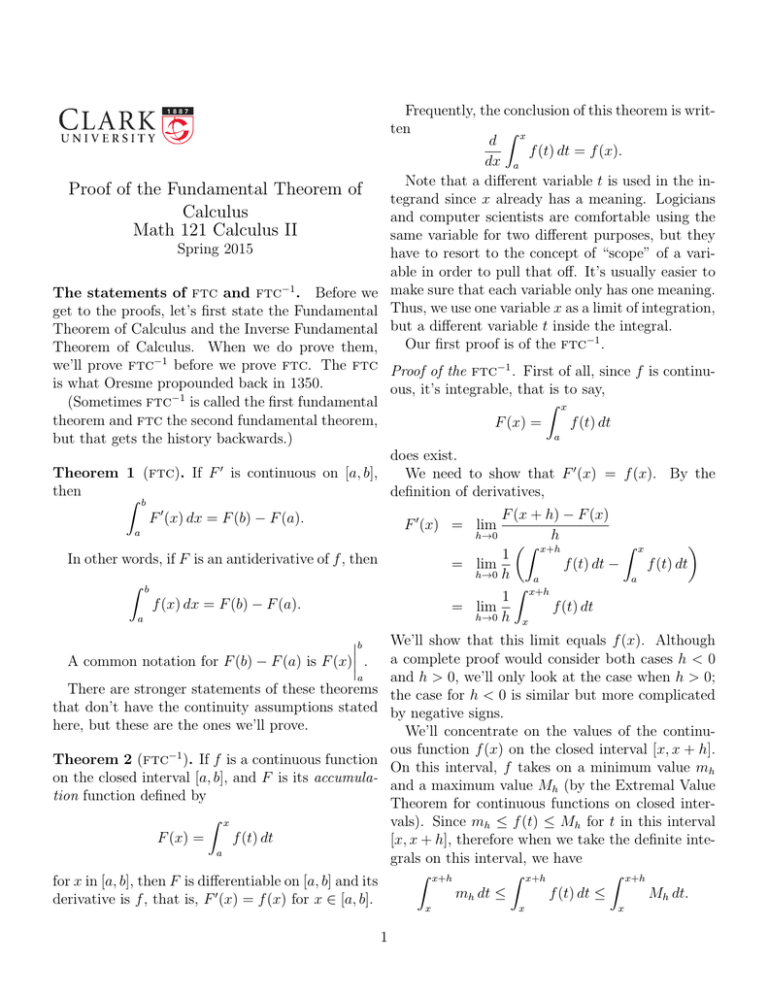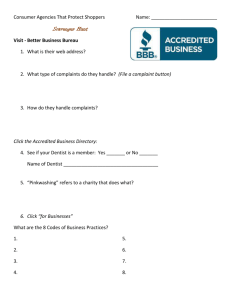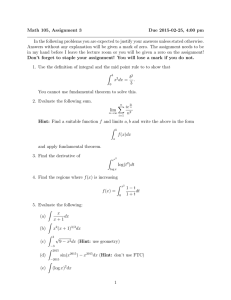Proofs of FTC
advertisement

Frequently, the conclusion of this theorem is written Z x d f (t) dt = f (x). dx a Note that a different variable t is used in the integrand since x already has a meaning. Logicians and computer scientists are comfortable using the same variable for two different purposes, but they have to resort to the concept of “scope” of a variable in order to pull that off. It’s usually easier to make sure that each variable only has one meaning. Thus, we use one variable x as a limit of integration, but a different variable t inside the integral. Our first proof is of the ftc−1 . Proof of the Fundamental Theorem of Calculus Math 121 Calculus II Spring 2015 The statements of ftc and ftc−1 . Before we get to the proofs, let’s first state the Fundamental Theorem of Calculus and the Inverse Fundamental Theorem of Calculus. When we do prove them, we’ll prove ftc−1 before we prove ftc. The ftc Proof of the ftc−1 . First of all, since f is continuis what Oresme propounded back in 1350. ous, it’s integrable, that is to say, Z x (Sometimes ftc−1 is called the first fundamental theorem and ftc the second fundamental theorem, F (x) = f (t) dt a but that gets the history backwards.) does exist. 0 Theorem 1 (ftc). If F is continuous on [a, b], We need to show that F 0 (x) = f (x). By the then definition of derivatives, Z b F (x + h) − F (x) h→0 h Z x+h Z x 1 = lim f (t) dt − f (t) dt h→0 h a a Z 1 x+h = lim f (t) dt h→0 h x F 0 (x) dx = F (b) − F (a). F 0 (x) = lim a In other words, if F is an antiderivative of f , then Z b f (x) dx = F (b) − F (a). a We’ll show that this limit equals f (x). Although a complete proof would consider both cases h < 0 and h > 0, we’ll only look at the case when h > 0; the case for h < 0 is similar but more complicated by negative signs. We’ll concentrate on the values of the continuous function f (x) on the closed interval [x, x + h]. Theorem 2 (ftc−1 ). If f is a continuous function On this interval, f takes on a minimum value mh on the closed interval [a, b], and F is its accumulaand a maximum value Mh (by the Extremal Value tion function defined by Theorem for continuous functions on closed interZ x vals). Since mh ≤ f (t) ≤ Mh for t in this interval F (x) = f (t) dt [x, x + h], therefore when we take the definite intea grals on this interval, we have Z x+h Z x+h Z x+h for x in [a, b], then F is differentiable on [a, b] and its mh dt ≤ f (t) dt ≤ Mh dt. derivative is f , that is, F 0 (x) = f (x) for x ∈ [a, b]. x x x b A common notation for F (b) − F (a) is F (x) . a There are stronger statements of these theorems that don’t have the continuity assumptions stated here, but these are the ones we’ll prove. 1 Z x+h Z x+h mh dt = hmh , and But x Mh dt = hMh , x so, dividing by h, we see that Z 1 x+h mh ≤ f (t) dt ≤ Mh . h x Now, f is continuous, so as h → 0 all the values of f on the shortening interval [x, x + h] approach f (x), so, in particular, both the minimum value mh and the maximum value Mh approach f (x). But if both mh and Mh approach the same number f (x), then anything between them also approaches it, too. Thus Z 1 x+h f (t) dt = f (x) lim h→0 h x thereby proving F 0 (x) = f (x). q.e.d. We’ll now go on to prove the ftc from the ftc−1 . Proof of the ftc. Let Z G(x) = x F 0 (t) dt. a Then by ftc−1 , G0 (x) = F 0 (x). Therefore, G and F differ by a constant C, that is, G(x) − F (x) = C for all x ∈ [a, b]. But Z a G(a) = F 0 (t) dt = 0, a and G(a) − F (a) = C, so C = −F (a). Hence, G(x) − F (x) = −F (a) for all x ∈ [a, b]. In particular, G(b) − F (b) = −F (a), so G(b) = F (b) − F (a), that is, Z b F 0 (t) dt = F (b) − F (a). a q.e.d. Math 121 Home Page at http://math.clarku.edu/~ma121/ 2





